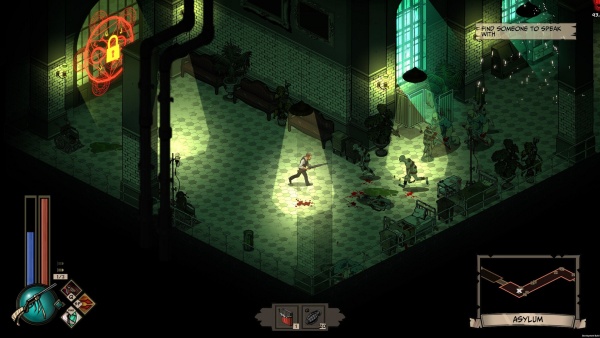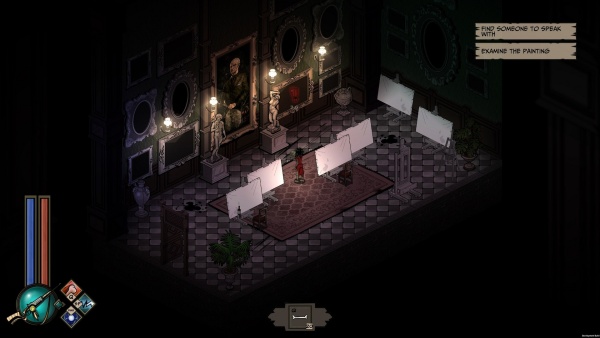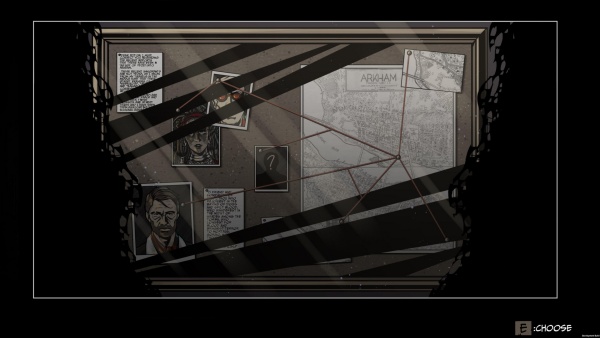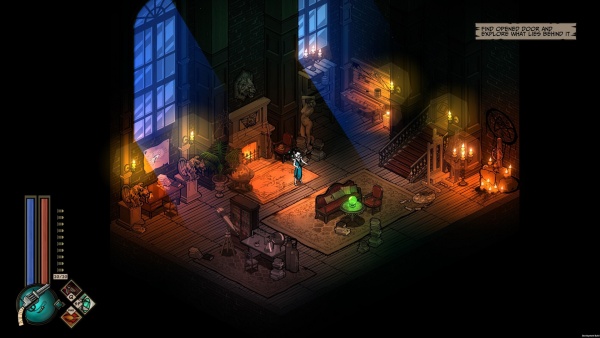The works of Lovecraft have had an immense influence over media, including books, films and especially with gaming. In recent memory and upcoming in the next couple of months, there have been dozens of games related to the bleak horrors of the cosmos and unknown. Whether these have been First Person Shooters or mystery adventures but nor have I seen what I played for this review. Imagine Hades, a rogue-like adventure game mixed up with Cthulhu lore, and this is what we got for Lovecraft’s Untold Stories 2. It sounds immense on paper … but sadly, concept and execution are two vastly different sides to the craft.
What is Lovecraft’s Untold Stories 2?
Players will embark on a horrifying journey of morbid discovery in this sequel to the 2019 action rogue-like. Experience much of what was loved from the original, but now with a revamped art style, taking the influence of 1920’s inky art (also seen in this year’s Forgive Me Father) and tighter combat elements.
Taking on the roles of several misfortune souls as they deal with the never-ending legions of the unknown, players will embark on personal tales of redemption, as each of the six souls is looking to stop the madness from growing further.
Each character has their own journey they must embark on, to rid the world of Lovecraftian evil in a vast number of locations from insane asylums to graveyards and places of demonic worship. Use various skills, magical powers and brute force to fight your way through randomly generated levels and collect vital gear throughout each mission to craft new gear, and weapons and become stronger in strength and mind to take on the mightiest of The Great Ones.
Gather your nerves and embark on a trip of insanity and bloodshed. This all sounds amazing, much like mixing up Forgive Me Father and Hades into one beautiful mess … and sadly, I really do mean that Lovecraft’s Untold Stories 2 is a beautiful mess.
Inky Horrors and the Cosmos
Visually speaking, Lovecraft’s Untold Stories 2 is a beautiful-looking game. I’m a sucker for this kind of heavily inky print art style and love the attention to detail here. The artists have clearly been passionate about revamping the art style from the first game and making it better than ever. I love the use of various grisly, sickly colours, the loving amount of detail in the world and the overall design of the world and the many creatures lurking in it. Everything is foreboding, creepy and unpleasant, but all this works well of course in a game centred on Lovecraftian Horror.
Having the aesthetics of a 1920’s inky comic book really enhances the level of intimidation for this type of horror, and while most modern games do a good job at presentation for themes centred on the cosmos, I find this type of art style the most fitting.
Sound design is generally not anything impressive, it still does a decent job at helping create that unsettling atmosphere you would expect in a game like this. With plenty of subtle noises, low-level chanting and creepy screams that will send shivers down your shine. Nothing that will leave you in a cold sweat at night but does the job it needs to. But the art style is the highlight of Lovecraft’s Untold Stories 2, as its timeless, beautiful, and unsettling in all the right ways.
The madness grows and consumes…
Lovecraft’s Untold Stories 2’s structure falls into choosing a character from the six damned souls and embarking on small ventures that involve fighting hordes of Lovecraftian beasts, solving bizarre mysteries, and surviving all manner of ungodly horrors. Each character has their own unique perks and abilities, from conquering magic spells, shifting great distances to avoid attacks, using highly advanced technology for crowd control, or simply having a good old double-barrel shotgun to blast giant tentacles to gooey bits.
You will gather vital components and raw materials needed to craft important gear to embark on more challenging missions and to become more powerful to face the eldest and the greatest of the unknown horrors. Strengthen your characters, craft new gear and weapons for the job at hand and embark on mysterious ventures as levels are randomly generated.
While the core gameplay loop does sound mighty fine, I kept thinking of one term out of many throughout my time playing Lovecraft’s Untold Stories 2, and that is “Early Access”.
Sadly, my time playing this was filled with a mix of disappointment and frustration, as much of the core gameplay feels unfinished and unbalanced. With every step forward I made, felt like the game was taking two steps back regarding combat, level design and the general bits in between that would otherwise be the compelling RPG elements.
While there were moments when things did click together and some fun occurred, there were many more which left me wondering why this had come out as a full release and not early access. And from user reviews on Steam, you can gather the ugly picture that sums up the game all too well.
Combat is a big offender in why Lovecraft’s Untold Stories 2 is feels undercooked, with enemy AI problems, poor design choices in combat arenas and the general unbalanced nature which will lead players to die a lot, and unjustly.
I did immensely enjoy the variety of enemies in the game, but they all behave and move in the same manner as each other. It didn’t matter if there were small globby enemies, heavy guys with shotguns or those in-between, all enemies felt the same. What would entail is I would enter an arena; enemies would spot me and they all b-line towards me in a massive group. This felt so weird and sucked out any meaningful tactical gameplay that could ensue. A game like DOOM would present a variety of enemies all with different behaviours and manoeuvres, thus creating a dynamic and engaging fighting experience.
Here, it presents both a complete nuisance and one of the biggest exploits the game offered, as I could lead them to an area where they would all be trapped, and I could land a devastating attack killing them all off.
But at the same time, if you’re cornered by a massive group, then you’re pretty much dead. I wouldn’t be so mad about this if the arena layouts were much better and sorry to say they’re not. Most combat arenas are very tight, have a lot of dead ends/blockers, and are littered with dozens of random objects which kill any momentum. It's easy to mistake a path, get stuck somewhere when you’re trying to escape, or just find yourself backed into a corner with no chance of survival.
Games like Hades and DOOM have big arenas, with plenty of advantages you and your enemies can make use of. There are always ways to loop around, ambush or escape a tricky situation if you’ve got good reflexes and are responsive. Those elements and thoughtful design choices are not present here, and combat overall feels very clunky.
Each character has its own unique powers and perks, and many of them are cool. Such as the Witch who can shoot out balls of fire from her skull and make speedy flashes across the arena to avoid damage. I liked the idea of different character attributes, giving players a chance at varied playstyles and engaging character moments, which differ from the last. But with the clunky arena designs and poor enemy AI, this doesn’t have the same impact it should.
It's quite strange, as the beginning area of the game seems well thought out, with death traps, enough space to fight and a good mix of enemies …. But then level by level, things just go sideways and everything mentioned above comes into play. As said, there were arenas which felt fun, but 80% of the time, came in the unbalanced enemy attacks, cluttered arenas and the controls never get better.
In short, the combat is just unfair, with oddly designed arenas filled with numerous blockers, enemies that all act the same and deal overpowered attacks, and clunky controls which really can kill the pacing. And worse of all, I noticed some blatant brokenness with certain enemy attacks, namely heavy enemies with firearms, and how their bullets will quite literally fly around corners to hit you … is that something Cthulhu related or more likely, just a broken enemy attack … I feel the latter.
Lots of cosmos fluff and crafting
Now I’m not a fan of hand-holding in my games, but there is a difference between hand-holding and guidance. Guidance is great to introduce you to various elements of the gameplay and core mechanics that you can make use of. Lovecraft’s Untold Stories 2 does nothing to teach you anything about the world and its mechanics, meaning you’ll have no idea what to do.
For instance, there are a "lot" of raw materials you gather through each level, quite literally dozens and dozens of items to loot. From the very beginning, you’ll be picking up countless items that it would make Diablo or Baldur’s Gate blush. Seeing how much there is to loot can be quite thrilling, but it's something that can easily confuse you, as little context is given upfront on what the hell you're collecting. I was picking up tons of materials and had no idea what it was for until I accidentally discovered the workbench. It was nice to be able to make items, but it's the same issue as in The Last of Us, where you'll be picking up items and most likely be doing that more than anything else. It can be rather tedious after a couple of hours, and the amount was a little much at times.
But regardless of this, the crafting system is a neat idea, and there are a ton of various contraptions and gear you can make which is great! From weapons, new clothes, and buff to help stop effects such as poison from ending a run. There are quite a lot of items as previously mentioned which feel unneeded, but I did like the fact there was plenty enough to craft all manner of items for all player types and events. Plus, Lovecraft’s Untold Stories 2 does relish its gothic themes and the random junk and bits all looked cool and had some neat lore to them (kind of like Dark Souls), even the random used tissue with Cthulu snot on it!
Yet still, there is plenty to pick up and while at times it feels random and a little long-winded, I did appreciate the quality of pickups and how this allowed a multitude of crafting.
Yet, the big problem with gathering items from runs is linked to my previous points about combat, and just how the game is justly difficult and ungodly unbalanced most times. Dying in other rogue-like games always gives you something, whether it be knowledge or some form of currency. For Hades, you get “Darkness” which you can use to upgrade various character traits such as health or a second attempt at a run if you die…. But here it's really about the materials and when you die, you drop them all. So, it turns into a grind fest, of dying unfairly, playing through clunky arenas, never progressing at a rate that’s enjoyable and just doing too much repeating.
Once you abandon a mission, there is nothing to show for it, and nothing that can slowly progress your character to be and do better in the next run.
The endless, empty void … of nothingnessNow it wouldn’t be a Cthulhu mythos game without an injection of madness, right? And again, Lovecraft’s Untold Stories 2 does have some neat ideas but nothing that excels or feels truly unique. You do of course have a sanity meter, which is shared by the whole group (interesting design choice …) and by reading certain documents and doing certain actions, the meter will increase or decrease. If the meter goes too high, then you’ll see visual alterations and soon enough, be brought to instant death.
My problem is that insanity feels very random and there is little cohesive logic to follow. I found reading random notes scattered around could either improve or diminish your sanity, so I felt after a while it was best not to look at notes, considering most of the positive ones didn’t offer any interesting insights (like enemy weaknesses or a safe code). And exploring the world/fighting enemies really didn’t make much of an impact either.
I could have easily missed a lot of key moments, but it felt like insanity was an afterthought and the developers didn’t have the time to integrate it in a meaningful way. Fighting too many enemies could increase it, or by looking at a painting too long could trigger an episode of madness. Instead, it feels dotted around and overall didn’t change much of the world or my playstyle.
Forgive Me Father, another cosmic horror game uses madness in interesting ways, both as a hindering and a blessing. It can be used as a weapon, powering up attacks and spells, or simply causing you to see things which aren’t there. I was hoping for more regarding madness, but there isn’t much here…
OverallI feel there is a great game here with Lovecraft’s Untold Stories 2, but with all the problems still present, it held back from achieving greatness in the genre. I certainly loved the art style and many of the concepts for thematic elements and gameplay. But there is a lack of development in certain mechanics, including the insanity meter, and even the story feels uneventful at most times. But the biggest issue holding back Lovecraft’s Untold Stories 2 is the combat, which could be great fun, yet instead is hugely unbalanced, cluttered with poor design choices and hinders the progression, making this rogue-like feel immensely grindy and unfair.
I can see there is immense potential here for a great rogue-like, but Lovecraft’s Untold Stories 2 feels like it should be in early access and needs more time in the oven for sure. I hope the developers will continue their efforts for improvements and fixes, as they clearly have talent and should work on more games. So, I will pray to the Great Ones that Lovecraft’s Untold Stories 2 will get more fixes in the future, but right now, this is surely a game to drive you somewhat mad.
+ Cool thematic elements and concepts
+ Looks and sounds very nice
+ Crafting is a cool idea with lots of items to find and make
--- Combat is so unbalanced and unfun
-- Lack of interesting gameplay dynamics and poor design choices
- Some gameplay elements feel under-developed
A Steam review key of Lovecraft’s Untold Stories 2 was provided by the publisher for the purpose of this review.




